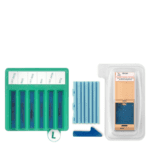Wyatt Anthony is a pathologists’ assistant, has worked in anatomic pathology for 13 years, and, like many people who have worked in a lab, he hates prostate biopsies. Ever since he started grossing as a path tech, then throughout graduate school, clinical rotations, and several different jobs, he and everyone he associated with dreaded prostate biopsy cases.
“Ever since I started grossing, I hated prostate biopsies. I’d rather do anything else. Now, I joke that I’m probably the only pathologists’ assistant in the country whose favorite specimen to gross is a prostate core case,” Anthony admitted.
How could a pathologists’ assistant go from hating to loving one of the “worst specimens” in anatomic pathology? Keep reading to find out how Lumea improves prostate grossing.
Why Prostate Cases are Some of the Worst for a Lab
Prostate core needle biopsies come with a myriad of issues. Most cases include 12 plus skinny cores that twist, curl, segment, and stick to each other, as well as the mesh cloths many clinicians use to help transfer them into formalin bottles. They are time-intensive in every step of the laboratory process, and labs only get reimbursed for a handful of the cores. It is a lot of work and headaches for very little in return. If you work in a lab that processes prostate specimens, this may sound painfully familiar.
To start, you check the name and site for every container at accessioning and again at grossing. Then, at grossing, you have to carefully remove each core from its container and check the lid in case some of the biopsies are stuck in the threading. Combined, these two steps in a lab can take up to an hour for a 12-core case.
“Embedding is a little bit faster, but it’s almost impossible to get a perfectly straight core,” Anthony shared. “And then there’s the cutting. It’s scary because, with prostate cores, you only have a few passes before you run out of tissue.”
Microtomy can easily take an hour. One 12-core prostate case takes more than two hours of full-time employee work, not including processing, staining, coverslipping, and scanning 12 slides. Less than four prostate cases are equivalent to a full day of pay.
After all that work, labs must store the slides and blocks for at least ten years. If a medical center processes 100,000 slides a year and takes five hours a day to file, that equals 1,300 hours a year dedicated solely to the filing.
Applying for the Job at PathNet
Anthony wanted to return to his native Utah, so he decided to apply when he saw a pathologists’ assistant position opening at PathNet’s Utah location. But then he heard it was a prostate lab.
“It made me nervous. I didn’t want to gross prostates for the rest of my life, but I wanted to move back to Utah. So, I decided to give this a shot and see what it was all about,” said Anthony.
How Prostate Biopsies are Better with Lumea Technology
 PathNet uses Lumea technology to power its lab. This tech includes two game-changing prostate biopsy inventions: the BxBoard® and BxChip®.
PathNet uses Lumea technology to power its lab. This tech includes two game-changing prostate biopsy inventions: the BxBoard® and BxChip®.
The BxBoard is a specimen storage and transport container. Instead of placing specimens in bottles, clinicians can use these boards to hold up to six core needle biopsies. The board’s lanes help keep cores straight and flat and reduce the risk of fragmentation. Cases arrive at PathNet in two boards instead of 12 bottles. The improved condition of the cores makes a technician’s job easier.
The BxChip is a microtissue array that holds up to six cores and processes with the tissue. It reduces block and slide count from twelve to two and reduces workload and material cost.
In a best-case scenario at PathNet, what used to take Anthony 30 minutes to gross now only takes five. This was a much better prostate-grossing experience than he had ever had before.
“It’s actually fun to gross prostates here. In a full day, I could gross 100 BxChips full of prostate cores by myself. If I had to do that same amount of cores the traditional way, it would take me a full week, and I would probably quit after the first day,” said Anthony.
Anthony also noticed how much time he saved in other aspects of the lab. Embedding time is reduced to seconds. An embedder no longer has to carefully remove and attempt to straighten and flatten each tiny core. Now, they remove two BxChips from their cassettes and flip them over to create two blocks.
Then, since a chip holds up to six cores, a twelve-core case only needs two blocks cut by the microtome, two slides to stain, and a coverslip, and the necessary storage space is reduced from 24 items to four.
With the time, space, and cost savings, PathNet can intake a much higher volume of prostate cases with fewer employees than other labs. And even better, their staff enjoy doing it.
“Everything about how we do it here is perfect for prostates,” says Anthony. “I love grossing them now.”
Do you want to learn more? Request a demo with Lumea to see how our technology can help you revolutionize your lab process, save money, and improve prostate grossing.

